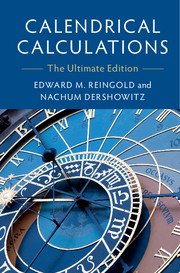Book contents
1 - Calendar Basics
Published online by Cambridge University Press: 22 March 2018
Summary
A learned man once asked me regarding the eras used by different nations, and regarding the difference of their roots, that is, the epochs where they begin, and of their branches, that is, the months and years, on which they are based; further regarding the causes which led to such difference, and the famous festivals and commemoration-days for certain times and events, and regarding whatever else one nation practices differently from another. He urged me to give an explanation, the clearest possible, of all this, so as to be easily intelligible to the mind of the reader, and to free him from the necessity of wading through widely scattered books, and of consulting their authors. Now I was quite aware that this was a task difficult to handle, an object not easily to be attained or managed by anyone, who wants to treat it as a matter of logical sequence, regarding which the mind of the student is not agitated by doubt.
Abū-Raihān Muhammad ibn ‘Ahmad al-Bīrūnī: Al-Āthār al-Bāqiyah ‘an al-Qurūn al-Khāliyah (1000)Calendrical calculations are ubiquitous. Banks need to calculate interest on a daily basis. Corporations issue paychecks on weekly, biweekly, or monthly schedules. Bills and statements must be generated periodically. Computer operating systems need to switch to and from daylight saving time. Dates of secular and religious holidays must be computed for consideration in planning events. Most of these calculations are not difficult because the rules of our civil calendar (the Gregorian calendar) are straightforward.
Complications begin when we need to know the day of the week on which a given date falls or when various religious holidays based on other calendars occur. These complications lead to difficult programming tasks—not often difficult in an algorithmic sense but difficult because it can be extremely tedious to delve into, for example, the complexities of the Hebrew calendar and its relation to the civil calendar.
The purpose of this book is to present, in a unified, completely algorithmic form, a description of over three dozen calendars and how they relate to one another.
- Type
- Chapter
- Information
- Calendrical CalculationsThe Ultimate Edition, pp. 1 - 52Publisher: Cambridge University PressPrint publication year: 2018

